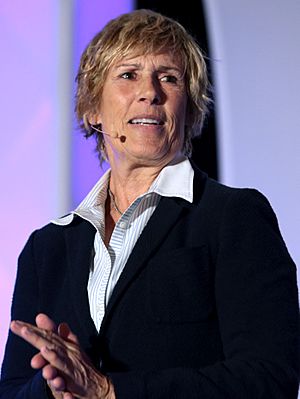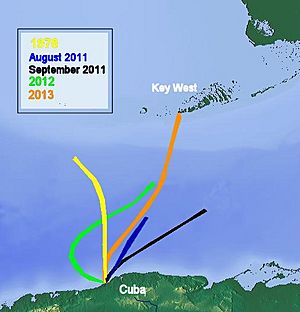Diana Nyad facts for kids
Quick facts for kids
Diana Nyad
|
|
|---|---|

Nyad in 2016
|
|
| Born |
Diana Sneed
August 22, 1949 New York City, New York, U.S.
|
| Education | Lake Forest College (BA) New York University |
| Occupation | Author, journalist, swimmer |
| Known for | Championship swimming; endurance swimming; journalism; motivational speaking |
Diana Nyad (born August 22, 1949) is an American author, journalist, and amazing long-distance swimmer. She became well-known in 1975 when she swam all the way around Manhattan Island. This swim was about 28 miles (45 km) long, and she set a new record time.
Nyad has written four books and many articles for different magazines. She also hosted a radio show called The Savvy Traveler. You might have seen her on TV shows like CBS News Sunday Morning or Dancing with the Stars. She was also a regular voice on public radio programs like All Things Considered.
In 2013, when she was 64 years old, Diana Nyad tried for the fifth time to swim from Havana, Cuba, to Key West, Florida. This journey was about 110 miles (177 km). She completed the swim, becoming the third person known to cross the Florida Straits. The two swimmers before her, Walter Poenisch in 1978 and Susie Maroney in 1997, used a shark cage. Poenisch also used fins and rested on his boat. Nyad did not use fins or a cage. She wore a special jellyfish suit and had shark divers and electronic shark repellent devices with her. Her Cuba to Florida swim was not officially watched by a sports group. Later, the World Open Water Swimming Association (WOWSA) did not officially confirm her swim. This was because some records were missing or unclear.
Her 2013 swim and her friendship with athlete Bonnie Stoll were made into a movie in 2023 called Nyad. The movie was based on her book Find a Way.
Contents
Early Life and School
Diana Nyad was born in New York City on August 22, 1949. Her parents were Lucy Winslow Curtis and William L. Sneed Jr. Her mother's family had a history of inventing things.
After her parents divorced, her mother married Aristotle Z. Nyad. He adopted Diana, and the family moved to Fort Lauderdale, Florida. This is where Diana started swimming seriously when she was in seventh grade.
She went to Pine Crest School in the 1960s. There, she trained with a famous swimming coach, Jack Nelson. She won two state championships in the backstroke. Diana hoped to swim in the 1968 Summer Olympics. However, in 1966, she got sick with a heart infection and had to rest for three months. When she returned to swimming, she was not as fast.
After high school, she went to Emory University. Later, she went to Lake Forest College in Illinois. There, she started focusing on long-distance swimming. She caught the attention of Buck Dawson, who helped her get into marathon swimming. In July 1970, she set a new women's record in a 10-mile (16 km) race in Lake Ontario. She finished 10th overall. After graduating from Lake Forest College in 1973, she continued her marathon swimming career.
Career Highlights
Diana Nyad has written several books. Other Shores (1978) is about her life and long-distance swimming. Basic Training for Women (1981) shares a fitness program for women. Boss of Me: The Keyshawn Johnson Story (1999) is about a football player. Find a Way (2015) tells the story of her journey to swim across the Florida Straits. She has also written for famous newspapers and magazines.
Nyad also hosted a public radio show called The Savvy Traveler from 2001 to 2004. She was a regular guest on the radio show All Things Considered and the TV show Sunday Morning.
A documentary film about her, The Other Shore, was released in 2013. In her 1978 book, Nyad described marathon swimming as a fight against the ocean. She said the only way to win is to "touch the other shore."
Distance Swimming in the 1970s
- 1974: In June 1974, Nyad set a women's record in a 22-mile (35 km) race in the Gulf of Naples. She finished in 8 hours and 11 minutes.
- 1975: At age 26, Nyad swam 28 miles (45 km) around Manhattan Island in New York City. She finished in just under 8 hours (7 hours 57 minutes). This broke a 48-year-old record.
- 1978: At age 28, she first tried to swim from Havana, Cuba, to Key West. She swam inside a steel shark cage for almost 42 hours. Her team stopped the swim because of strong winds and waves. She had covered about 76 miles (122 km).
- 1979: On her 30th birthday, she swam from North Bimini Island, Bahamas, to Juno Beach, Florida. She did this without a shark cage or a wetsuit. This swim was reported to be between 60 and 89 miles (97 and 143 km) long.
Cuba to Florida Swim Attempts (2011–2013)
Getting Ready
In early 2010, Nyad began training to swim from Cuba to Florida. This distance is over 110 miles (177 km). She trained in the Caribbean and then in Key West. She did long swims, including a 24-hour swim. When asked why she wanted to do this at age 60, she said, "Because I'd like to prove to the other 60-year-olds that it is never too late to start your dreams."
Her team was large, with about 25 people. They included navigators, doctors, and shark experts. The cost of her "expedition" was about $500,000. For the swim to work, the weather needed to be just right. This meant low winds and warm water temperatures. Nyad gained weight to help her body handle the long swim.
She was guided by a kayak with an electronic shark repellent. To help her swim in a straight line, her support boat used a special streamer underwater. At night, the streamer had red LED lights. This helped her stay on course.
Second Try
On August 7, 2011, Nyad started her second attempt from Havana. She used electronic "Shark Shields" but no shark cage. She stopped after 29 hours because of strong currents and winds. She also had shoulder pain and asthma problems.
Third Try
On September 23, 2011, Nyad began her third attempt. Again, she did not use a shark cage. She stopped after 41 hours because of jellyfish stings. She was stung by box jellyfish on her arm and neck, which made it hard to breathe.
Fourth Try
On August 18, 2012, Nyad started her fourth attempt. She did not use a protective shark cage. She and her team ended the swim on August 21, 2012. This was due to two storms and nine jellyfish stings. She had covered more distance than her previous tries.
Fifth Try
On August 31, 2013, Nyad began her fifth attempt to swim from Havana to Florida. She was with a 35-person support team. She swam without a shark cage. To protect herself from jellyfish, she wore a silicone mask, a full bodysuit, gloves, and booties. She also had boats using electronic shark deterrents and shark divers.
On September 2, 2013, Nyad reached the beach in Key West. This was about 53 hours after she started. After her swim, some people had questions about the details. The New York Times published her GPS data. A professor confirmed that strong ocean currents helped her speed at times. Nyad said her swim was "fair and square."
Her swim from Cuba to Florida has not been officially confirmed by sports groups. In 2022 and 2023, the World Open Water Swimming Association (WOWSA) looked into her swim again. They decided not to confirm it. This was because some observer logs were missing, and there were different stories from her crew. Guinness World Records first recognized her swim but later removed their certification.
October 2013 Charity Swim
From October 8 to 10, 2013, Nyad did a "Swim for Relief." She swam for 48 hours straight in a special pool in New York City. This event raised $105,001.00 for AmeriCares. The money helped people affected by Hurricane Sandy.
Dancing with the Stars Performances
On March 4, 2014, Diana Nyad was a contestant on the 18th season of Dancing with the Stars. She was partnered with professional dancer Henry Byalikov. She finished in last place on the show.
| Week # | Dance/song | Judges' score | Result | ||
|---|---|---|---|---|---|
| Inaba | Goodman | Tonioli | |||
| 1 | Foxtrot / "Beyond the Sea" | 6 | 6 | 6 | No Elimination |
| 2 | Cha-cha-cha / "Move Your Feet" | no score given | Eliminated | ||
Awards and Honors
Diana Nyad has received many awards for her amazing achievements.
- In 1986, she was added to the United States National Women's Sports Hall of Fame.
- She is also honored in the International Swimming Hall of Fame (1978).
- Her colleges, Lake Forest College and Pine Crest School, have also honored her.
2014
- Nyad received the first ESPN Sports Science Newton Award.
- She was named Athlete of the Year by the L.A. Sports Council.
- She was inducted into the National Gay and Lesbian Sports Hall of Fame.
- Nyad received the Jack LaLanne Award.
- She received the Orden al Mérito Deportivo (Order of Sporting Merit) Award from Cuba.
- A bronze plaque honoring Nyad was placed on a wall near Smathers Beach in Key West. This is where she finished her Cuba-to-Florida swim.
- National Geographic named Nyad one of their Adventurers of the Year.
2015
- Marie Claire magazine featured Nyad in their "The 8 Greatest Moments for Women in Sports."
- A chapter in the book The Right Side of History: 100 Years of LGBTQ Activism was written about Nyad.
See also
 In Spanish: Diana Nyad para niños
In Spanish: Diana Nyad para niños


